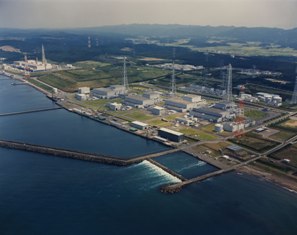 An earthquake of magnitude 6.8 struck Japan's Niigata prefecture on 16 July. Four nuclear power reactors at Kashiwazaki Kariwa shut down automatically, while one of them suffered a short-lived transformer fire and a small amount of water spilled from a used nuclear fuel cooling pool.
An earthquake of magnitude 6.8 struck Japan's Niigata prefecture on 16 July. Four nuclear power reactors at Kashiwazaki Kariwa shut down automatically, while one of them suffered a short-lived transformer fire and a small amount of water spilled from a used nuclear fuel cooling pool.
The earthquake, centred about 250 km northwest of Tokyo, hit at around 10.13 am, injuring more than 1000 people while destroying 300 buildings. Many roads were cracked, a temple roof collapsed and 35,000 people lost their water supply. Nine were killed.
At the Kashiwazaki Kariwa nuclear power plant, three of seven reactors - units 3, 4 and 7 - were in operation. Those reactors shut down safely as tremors began. Unit 2 was in the process of starting operation, and all systems shut down automatically as well.
Units 1, 5 and 6 were not operating as periodic inspections were being carried out. The tremors caused 1.2 cubic meters of water to spill from the used nuclear fuel cooling pond of unit 6. Plant owners Tokyo Electric Power Company (Tepco) said the water would contain 90 kBq of radioactivity, and had drained from the plant building to the sea in accordance with environmental regulations. The cooling pond itself was undamaged.
There was also a fire in the transformer of unit 3 following the earthquake. Tepco said this had been safely extinguished by 12.10 pm.
Transformers are used in all types of power station. As part of the system connecting the power unit's generator to the transmission grid, they step up the voltage of the electricity generated by the plant for transmission of energy over great distances without high losses. They are large oil-cooled components which deal with very high energy loads. As such they are located in designated and separated area of the plant and provided with ad-hoc monitoring systems, back-up units and fire protection.
In addition, Tepco said hundreds of drums of solid low-level radioactive waste (LLW) in the plant's solid waste storage facility fell from position. The lids of dozens of these were found open. LLW is typically composed of paper, filters, lightly-contaminated clothing and tools. Shigenori Makino of Tepco told World Nuclear News that the LLW drums in the facility contained either ash resulting from the incineration of flammable LLW items, the flammable items prior to incineration, or inflammable items as-is.
Tepco is currently inspecting all seven nuclear power units at the plant to assess what damage, if any, the earthquake may have caused and the exact reason for the transformer failure.
The earthquake was the biggest to affect the region since one of magnitude 6.8 in 2004. At that time no damage was recorded to the Kashiwazaki Kariwa plant.
Further information
Tokyo Electric Power Company (Tepco)
WNA's Nuclear Power in Japan information paper
WNA's Nuclear Power Plants and Earthquakes information paper
WNA's Earthquakes and Nuclear Safety microsite
WNN: Maanshan 2 shutdown during Taiwan quake




_47120.jpg)
_23621.jpg)

_63865.jpg)





